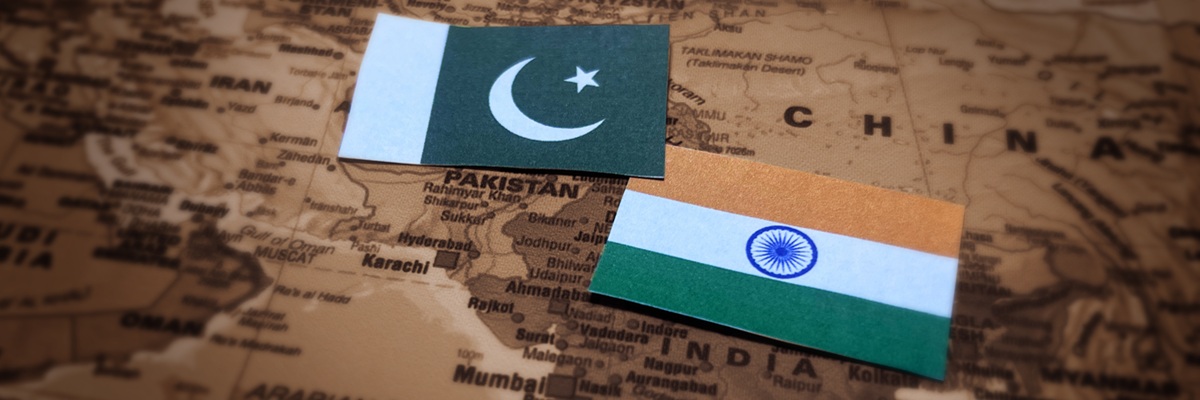Diplomacy
Comparative analysis of India and Pakistan's foreign policy through a postcolonial lens

Image Source : Shutterstock
Subscribe to our weekly newsletters for free
If you want to subscribe to World & New World Newsletter, please enter
your e-mail
Diplomacy

Image Source : Shutterstock
First Published in: Sep.29,2025
Sep.29, 2025
The 1947 partition of British India gave rise to two sovereign states, India and Pakistan, that inherited similar colonial legacies but developed starkly divergent foreign policy paths. These differences were not purely strategic but were rooted in how each state interpreted its postcolonial condition. While India adopted a policy of non-alignment to protect its sovereignty in a bipolar world, Pakistan aligned itself early with Western powers, prioritizing security over autonomy. These choices, driven by internal insecurities, historical trauma, and leadership visions, shaped their global engagements for decades. This paper argues that the postcolonial experiences of both countries profoundly influenced their foreign policies, with India pursuing strategic autonomy and soft power projection, while Pakistan adopted dependency-based alignments driven by survival instincts and regional insecurity.
Post-colonialism and Foreign Policy Identity
Post colonialism refers to the condition of states that have emerged from the yoke of colonial rule and are navigating their way toward independent identity formation, both domestically and globally. It is a political, cultural, and psychological process that involves reasserting autonomy after years of subjugation (Cvetanovska et al., 2016). For India, postcolonial diplomacy was a tool to construct an independent identity distinct from the former colonizers and the Cold War superpowers. Nehru's advocacy for the Non-Aligned Movement (NAM) in the 1950s was deeply rooted in India’s postcolonial ethos of resisting domination, militarism, and Western dependency (IRJSSH, 2024).
Pakistan’s postcolonial trajectory was markedly different. The trauma of partition, including widespread violence and the loss of territory, fostered an intense sense of vulnerability. Lacking economic strength and surrounded by perceived hostilities particularly India Pakistan's leadership quickly sought external patrons, viewing alignment as essential for its survival. In 1954, Pakistan joined the Southeast Asia Treaty Organization (SEATO) and later the Central Treaty Organization (CENTO), receiving substantial U.S. aid in return (Ahmar, 2024). This early dependence on Western powers shaped Pakistan’s foreign policy as one centered on external security guarantees rather than autonomous diplomacy.
India’s Evolving Foreign Policy
India's foreign policy evolved in three broad phases:
1. Idealist non-alignment (1947–1971)
2. Pragmatic balancing (1971–1991)
3. Multi-alignment with strategic autonomy (1991–present).
In its early years, India sought to play a moral leadership role among decolonized nations, promoting peace, non-intervention, and South-South cooperation. Nehru’s role in establishing the NAM in 1961 underscored India's desire to remain outside Cold War binaries and carve a distinct place for itself on the world stage (Taneja, 2019).
However, India’s 1962 border war with China revealed the limitations of idealism. This military defeat prompted a rethinking of foreign policy, leading to closer ties with the Soviet Union. By 1971, India had signed the Indo-Soviet Treaty of Peace, Friendship and Cooperation, signaling a partial alignment to protect regional interests, especially as it supported Bangladesh’s liberation (Ahmar, 2024).
India’s economic liberalization in 1991 was a turning point. With its economy opening to global markets, foreign policy began prioritizing trade, investment, and strategic partnerships. India launched the “Look East” policy, now rebranded “Act East,” to deepen ties with ASEAN and East Asian powers. Simultaneously, India cultivated strong relations with the United States, particularly in defense, nuclear cooperation, and technology transfer (IRJSSH, 2024).
Under Prime Minister Narendra Modi, India has expanded its global footprint further by participating in multilateral platforms like the QUAD, BRICS, G20, and the SCO. It has also invested in soft power diplomacy, promoting yoga, Bollywood, and higher education as cultural exports. India’s campaign for a permanent seat at the UN Security Council and its 2023 G20 presidency signal its aspiration to emerge as a major global player.
Pakistan’s Security-Oriented Diplomacy
Unlike India’s autonomy-focused policy, Pakistan’s foreign policy has remained anchored in strategic partnerships, primarily driven by regional security anxieties. Its early Cold War alliances with the U.S. brought military and economic support, including weapons, aid, and development funding. However, these benefits came at the cost of diplomatic flexibility. Pakistan became part of the American containment strategy rather than a voice for postcolonial solidarity (Ahmar, 2024).
During the 1970s, Zulfikar Ali Bhutto attempted to diversify foreign ties by engaging China and Islamic states. Yet, Pakistan remained entangled in great-power politics. The Soviet invasion of Afghanistan in 1979 marked another watershed moment: Pakistan became a frontline state in the U.S.-backed resistance, supplying weapons and training to the mujahideen. While this brought short-term geopolitical relevance and aid, it also sowed the seeds of extremist militancy that later destabilized the region (The Guardian, 2025).
In the post-9/11 era, Pakistan again aligned with the U.S. as a key ally in the War on Terror, receiving billions in aid. However, mistrust over counterterrorism commitments led to strained relations. More recently, Pakistan has deepened ties with China through the China-Pakistan Economic Corridor (CPEC), a multi-billion-dollar initiative under the Belt and Road Initiative. CPEC has transformed infrastructure and energy access but raised concerns about rising debt and reduced strategic independence (Financial Times, 2025).
Simultaneously, Pakistan has relied heavily on Gulf states like Saudi Arabia and the UAE for financial bailouts. However, the country’s emphasis on Islamic solidarity has not always translated into diplomatic support—especially on the Kashmir issue—where economic interests increasingly override religious or ideological ties (Economic Times, 2025).
Comparative Analysis
Although born from the same colonial womb, India and Pakistan followed radically different paths in foreign relations. India’s strategic approach has evolved from Nehruvian idealism to Modi’s pragmatic multi-alignment, allowing it to maintain relationships with the U.S., Russia, and China simultaneously. It has strengthened its global standing through economic diplomacy and soft power, investing in trade, culture, and multilateralism (IRJSSH, 2024).
Pakistan, meanwhile, has remained stuck in a pattern of dependency, cycling through major power patrons to meet its security and economic needs. Its alliances have often been transactional and security-driven, resulting in short-term gains but long-term vulnerabilities. This reliance on external support has constrained Pakistan’s ability to assert an independent foreign policy agenda (Cvetanovska et al., 2016).
India’s soft power and diaspora networks have significantly enhanced its global image, while Pakistan’s foreign relations have been more narrowly focused and reactive. Moreover, India’s diversified diplomatic strategy has helped it gain global influence despite regional tensions. Pakistan’s narrower diplomatic focus has limited its ability to pivot globally beyond its traditional allies.
Conclusion
India and Pakistan’s foreign policies reflect not just their immediate strategic calculations but also how each internalized its postcolonial legacy. India transformed its colonial trauma into a quest for autonomy and leadership among the Global South. Its foreign policy matured from idealism to realism, culminating in strategic flexibility and global engagement. Pakistan’s path, however, was shaped by existential insecurity, leading to a foreign policy centered on alliances for survival.
This comparative lens reveals the long-term consequences of early postcolonial choices. India’s foreign policy has grown more self-reliant and global, while Pakistan remains vulnerable to dependency, volatility, and limited diplomatic bandwidth. Understanding these divergent trajectories is crucial for comprehending the subcontinent’s enduring tensions and each state’s future on the global stage.
Bibliography
Ahmar, M. (2024). Post-Independence Compulsions and Pakistan’s Foreign Policy. Pakistan Horizon.
Alden, C., & Aran, A. (2016). Foreign Policy Analysis: New Approaches (2nd ed.). Taylor & Francis.
Cvetanovska, D., Nurgaliyeva, L., & Saidov, A. (2016). India–Pakistan Relations from Foreign Policy Perspective. Journal of Political Studies, 23(1), 45–59.
Economic Times. (2025). Why countries still support Pakistan despite terror
Financial Times. (2025). Pakistan’s strongman courts the US while drawing closer to China.
IRJSSH. (2024). Comparison of foreign policy of Pakistan and India during 1947 to 2023. International Research Journal of Social Sciences and Humanities, 3(1), 861–871.
Taneja, K. (2019). India’s Grand Strategy: From Nonalignment to Multi-Alignment. Oxford University Press.
The Guardian. (2025). Thawing of relations between Pakistan and the US.
First published in :
World & New World Journal

Sana Mumtaz is an International Relations professional with experience working with multiple NGOs, including Nighat Welfare Organization and Aurat March. She is dedicated to women’s development and committed to advancing impactful public administration. Her expertise spans gender policy, foreign policy, and sustainable social progress
Unlock articles by signing up or logging in.
Become a member for unrestricted reading!